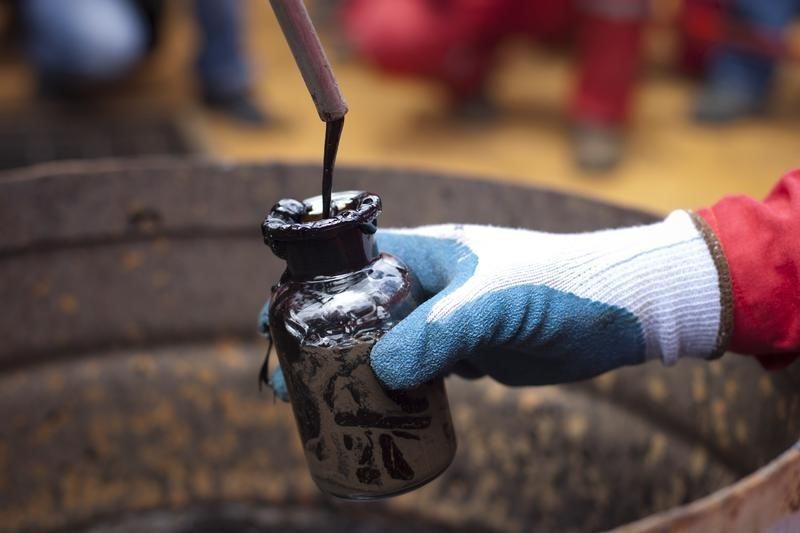By Barani Krishnan
Investing.com — Oil prices are headed for a modest weekly loss after a rollercoaster week where the market was buoyed by a Suez Canal jam squeezing crude supplies and buffeted at the same time by Europe’s third wave of Covid-19.
In all probability, the volatility will extend into next week when producer alliance OPEC+ meets to conceivably vote against a hike in production due to the challenges posed by new lockdowns in Europe. “It is more likely that the group will look to extend production cuts,” Phil Flynn, an energy analyst at the Price Futures Group in Chicago, said.
New York-traded West Texas Intermediate, the benchmark for U.S. crude, was up $2.41, or 4.1%, at $60.97 by 12:20 PM ET (16:20 GMT). For the week though, it was down 0.7%, extending last week’s 6.4% drop and the previous week’s 0.7% slide.
London-traded Brent, the global benchmark for crude, was higher by $2.45, or 4%, at $64.40 on the day. For the week, it showed a decline of 0.2%, adding to the combined 7% loss of the previous two weeks.
Since Tuesday, oil has gyrated in a yoyo-like fashion, falling 6% before recovering almost all of that the next day, and then taking another downward turn on Thursday with a 4% drop that was recouped in the current session.
Friday’s rebound came amid reports that it could take weeks to dislodge a giant container ship blocking the Suez Canal — a development that could delay the global movement of crude and refined products well into mid-April. Shipping rates for oil product tankers have already almost doubled this week, responding to the crisis.
The Suez Canal is jammed after powerful winds forced Ever Given — a Panama-flagged, Taiwanese-operated and Japanese-owned ship — aground on one of its banks. The blockade has disrupted one of the world’s most important maritime arteries, through which roughly 10% of global shipping traffic passes.
According to tanker tracking firm Kpler, of the 39.2 million barrels per day (bpd) of total seaborne trade in crude in 2020, 1.74 million went through the canal. Additionally, 1.54 million barrels daily of refined oil products such as gasoline and diesel fuel flow through the waterway, making up about 9% of global seaborne product trade.
As of Friday, hundreds of ships were stuck at each end of the 120-mile passage which connects the Red Sea to the Mediterranean. A Dutch salvage firm — which has rescued and recovered dozens of ships and wrecks from sea, including the Russia's Kursk nuclear submarine from the Barents Sea floor — is working to free the Ever Given tanker, which diagonally is said to be as long as New York's Empire State Building is tall.
Crude prices were also lifted somewhat by reports that Yemeni Houthi forces had launched attacks on Thursday on facilities owned by Saudi Arabia’s state oil company Aramco (SE:2222). For weeks now, such Houthi attacks have been reported and quickly discounted for impact, providing nothing more than fleeting support to the oil market.
More important though was what the OPEC+ alliance will do next week — particularly what its figurehead, the Saudis, will think up to try and bring back the mojo in a market that rallied nearly four months non-stop before last week’s stunning 7% drop that set it on a rollercoaster motion.
Since April, the 23-nation OPEC+ — made up of the 13-member Saudi-led Organization of the Petroleum Exporting Countries and 10 non-OPEC nations steered by Russia — has withheld between nine and seven million barrels per day of regular supply from the market.
Those cuts helped WTI rise from a little under $36 per barrel on Oct. 30 to reach just below $68 by March 8. Brent went from beneath $38 to just above $71 in that same stretch. But over the past fortnight, the two benchmarks have lost about 10% from those highs.
The most critical component of the OPEC+ cuts has been the Saudi portion — which has accounted for anywhere between one and two million barrels per day since April.
In January, when the market was actively betting on the alliance to hike production amid strengthening signs of demand recovery from the coronavirus pandemic, the Saudis doubled down with an additional one million-barrel cut for February and March, sending crude prices soaring. They pulled off a similar stunt last month, after bypassing the opportunity to raise production for April.
At next week’s meeting for May quotas, the smart money is on the Saudis to try and clamp down on output again, though some analysts said the kingdom’s propensity to surprise was beginning to fade.
“You do it once, it’s a surprise. Twice maybe. Third time? I wouldn’t think so,” said John Kilduff, partner at New York energy hedge fund Again Capital. “I think another cut is already baked into the cake and the market is beginning to get a little desensitized to the OPEC show.”
